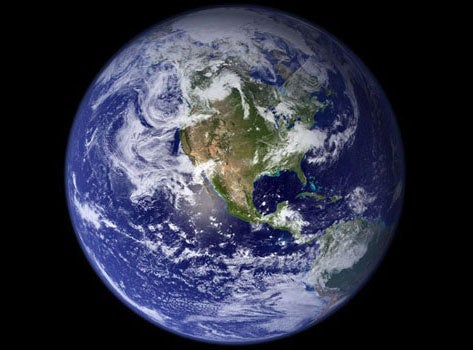|
July 5, 2012
Stanford students question scholars about a new era of Earth's history – the Anthropocene
A new course and podcast project, created by Stanford students, seeks to explain the Anthropocene, a term scientists are considering for a new geological period defined by human impact on the planet. By Rob Jordan

Scientists - including Nobel Prize-winning chemist Paul Crutzen, who coined the term - put the Anthropocene's starting point in the mid-1700s, the dawn of the Industrial Revolution. (Photo: NASA)
You've heard of the Ice Age and the Jurassic period. What about the Anthropocene?
In a new podcast series, Stanford faculty and staff explain the term, defined by when humans started having the most dramatic impact on the planet, and discuss why it's getting so much attention and what it means for 21st-century environmental issues.
"Anthropocene, I think, is a fantastic word," said Terry Root, a senior fellow at the Stanford Woods Institute for the Environment, in her interview for the Generation Anthropocene podcast. "It's making people realize that humans actually can affect the ground, the water, the air, everything. It's something people really need to be aware of because they're not if we don't tell them."
The official name for our current epoch is the Holocene. The term Anthropocene, which comes from the Greek anthropos (man) and ceno (new), was coined by Nobel Prize-winning chemist Paul Crutzen about a decade ago.
He, and many scientists since then, say the Holocene is over and this new epoch has begun. They put the Anthropocene's starting point in the mid-1700s, the dawn of the Industrial Revolution. It has been informally called the Age of Man.
Though the term is gaining steam among geologists, the Royal Society, a British organization of world-renowned scientists, will have final say whether to designate the Anthropocene as an official geologic period.
Meanwhile, doctoral students Mike Osborne and Miles Traer got the idea to delve more deeply into the topic as a way to educate not only themselves and other students, but also a wider audience.
"While the Anthropocene is an idea that arose from the Earth sciences, we view it as a conversation starter that opens the door to a wide range of discussion topics," Osborne said.
Podcasting the planet
The podcast project began with a conversation between Osborne and Traer last fall. They were talking about an Economist magazine article titled "Welcome to the Anthropocene."
Where, they asked each other, would they put the boundary of when human impact on the globe – the damming of rivers and polluting of air, for example – touched off a new era? At first, they thought it was a largely academic question.
"Fast forward two-and-a-half hours, and we realized it had some meat to it," Traer said recently.
Osborne envisioned a project for Stanford students, enlisted the support of Thomas Hayden, a lecturer with the Emmett Interdisciplinary Program in Environment and Resources, and successfully petitioned the Earth Systems program to offer a class called Podcasting the Anthropocene.
Osborne, Traer and Hayden taught the course together.
"Come up with your dream conversation and who you want to talk to," Osborne told the students. "We'll give you an excuse to do it." The resulting project was "one part education, one part science communications."
The students arranged interviews with a broad range of experts from an anthropologist to an agricultural ecologist and recorded them at Stanford's radio station, KZSU. Afterward, the students swapped audio files and gave each other constructive criticism for editing.
Osborne and Traer edited the audio and planned the podcast's framework.
In her interview, Root talks about her approach to biodiversity loss, Earth science communication and the far-reaching impacts of humankind.
"The more students learn about translating scientific information in a way that the general public can understand, the better," Root said of her participation in the podcast project.
Media attention
In the weeks since the Generation Anthropocene website went live, it has received thousands of hits and coverage from media outlets such as Scientific American and the environmental website Grist.
That kind of coverage is key, said interviewee Rodolfo Dirzo, the Bing Professor of Environmental Science, director of the Center for Latin American Studies and a senior fellow at the Stanford Woods Institute.
"I am convinced that an important element in addressing this crucial issue is to share its significance with the public at large. I truly believe that projects such as this can contribute to our collective responsibility for, and motivation to, making sure the manifestations of the Anthropocene can be attenuated as much as possible, as soon as possible," Dirzo said.
With support from the School of Earth Sciences, Osborne, Traer and Hayden plan to continue the project this summer, beginning with interviews of fellows in the Leopold Leadership Program, an academic leadership education initiative of the Stanford Woods Institute.
"Our pipe dream is to establish this as a model program for both education and interdisciplinary science outreach," Osborne said.
Rob Jordan is the communications writer for the Stanford Woods Institute for the Environment.
-30-
|